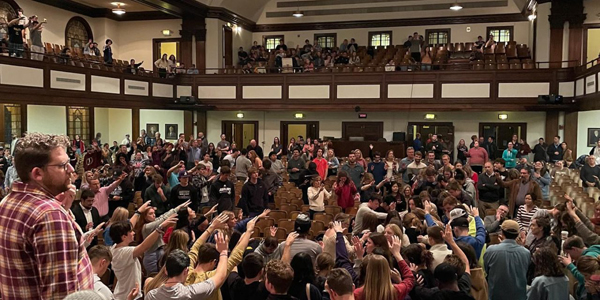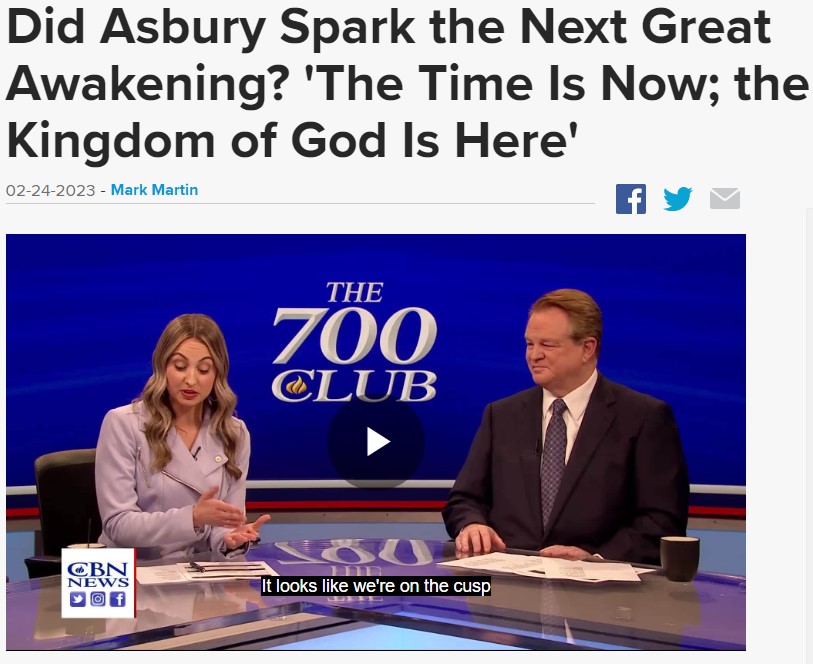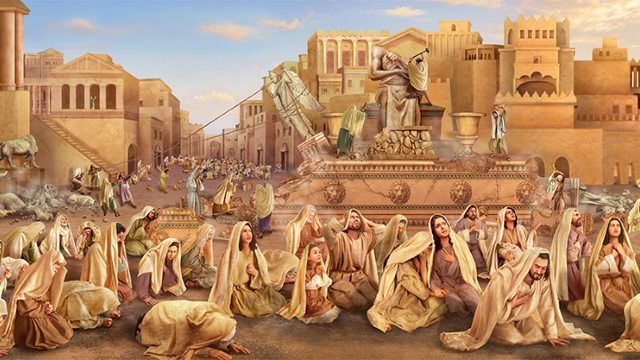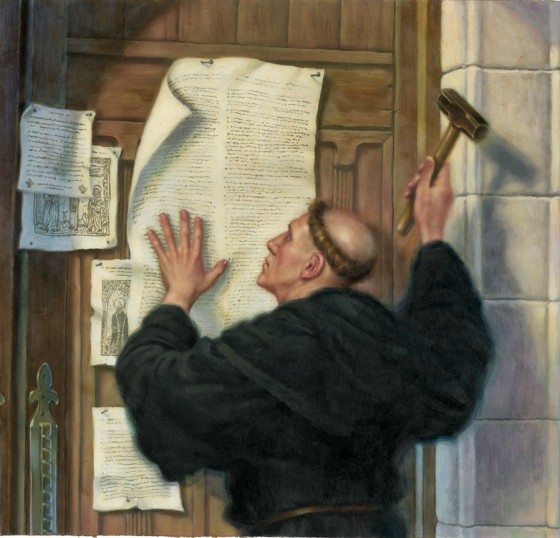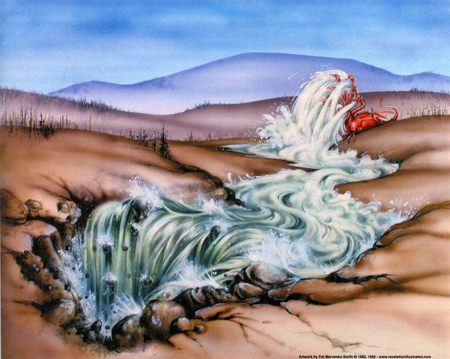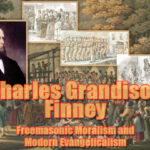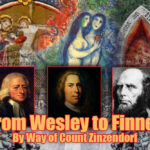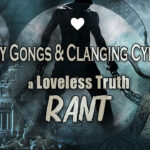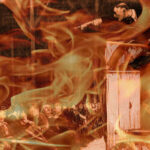Updated 2/2/25*
*** I’ve started a Youtube Playlist of all the articles in this series. Here’s part 1:

When the “revival” at Asbury started making the news, I initially intended this to be just one article about it, but I came across so much information that I decided to break it up into several parts. This first one will look at what people were saying about Asbury and talk a bit about just constitutes a “revival.” Lastly, we’ll look at an overview of the “Great Revivals.”
What People Were People Saying About Asbury?
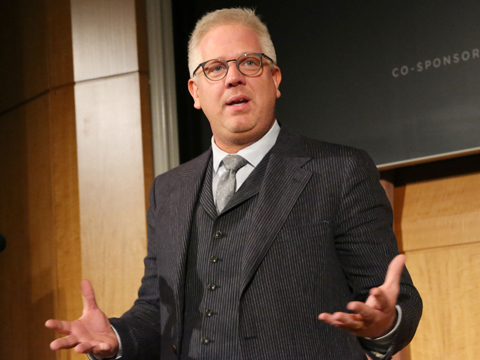
Mormon – Glenn Beck called the Ecumenical “revival” at Asbury “a miracle” adding that it is giving him “more hope than any other ‘good news’” and that “this may be the biggest story of this time” – glennbeck.com.

Roman Catholic – Father Norman Fischer of St. Peter Claver Church in Lexington, Kentucky is recorded in an article in The Record; ‘Jesus was right next to me’: Asbury revival sets Catholics on fire with Holy Spirit as saying, “It’s almost like a wellspring. You just know right away that God is there.”
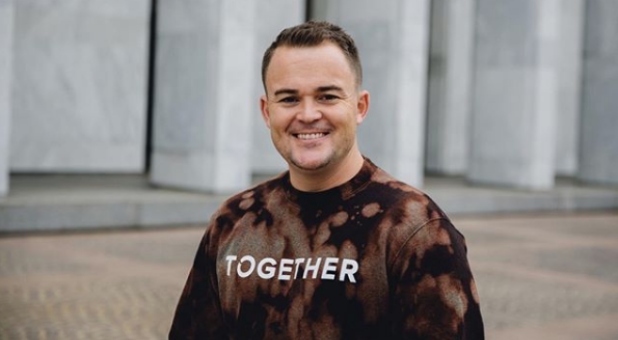
(Ecumenical) National Association of Evangelicals (NAE) Board Member – Nick Hall (NAE is a member of the globalist World Evangelical Alliance (WEA) also reported the familiar miracles marking christian revival events.
“I am forever undone by this week. I will never be the same… There were so many miracles. A man came in a wheelchair who hadn’t walked in two years and danced on the platform. I don’t even have a paradigm for what the heck is happening!” CBN
While the Asbury “revival” doesn’t classify as an “evangelistic meeting” in that it had few to no speakers, Christian evangelist Nick Hall told CBN that “so many people were saved!” My immediate question was “Saved by what gospel? How can there be a gospel presentation when attendees don’t even have a common understanding of the identity of Jesus Christ much less His Gospel?”
So faith comes from hearing, and hearing through the word of Christ. (Rom 10:17)
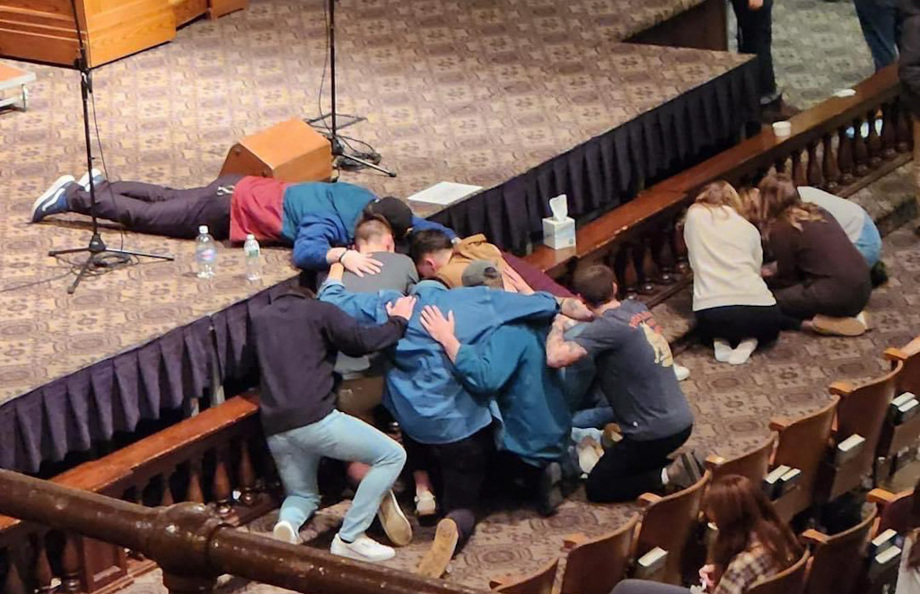
One Asbury professor said that “outpouring” would be a better term for the phenomenon than “revival.” But where is the scriptural support for an “outpouring” of the Holy Spirit to “revive” believers once they are born in spirit?
“For false christs and false prophets will rise and show great signs and wonders to deceive, if possible, even the elect. See, I have told you beforehand.” (Matt 24:24)
There isn’t any.
Stan Key, Minister at Large with OneWay Ministries, told Mission Network News,
“Pray, not just for young people, but for the United States to seek the face of the Lord in obedience and reverence to His will. Pray for this movement of the Holy Spirit to spread out from Asbury University and ignite a new generation passionate for the Gospel [again – what gospel?]. That’s what many of us are praying and longing for: That this is not a campus event. That God would move across our nation.” – Stan Key, Mission Network News
Where is the New Testament scriptural support for NATIONS to CORPORATELY PRAY or REPENT?

NAR false prophet Dutch Sheets told Flashpoint’s Gene Bailey that he’d seen the Ecumenical gathering in a 2001 dream.
“I saw incredible power, incredible fire, a fire of revival, incredible signs and wonders, incredible passion, love for God, worship, spontaneous outbreakings of Holy Spirit until the entire nation was on fire with the … fires of revival.” – Flashpoint
Bailey said it sounded like the Jesus Movement, except at “a higher level.” We’ll be getting to the Jesus Movement later.
 What is Revival?
What is Revival?
The concept of “Revival” has always eluded me. I attended one of Billy Graham’s Outreach “Crusades” several years ago and felt oddly isolated as I somehow lacked the emotional fervor that was overtaking the people around me. I wondered if the people who were walking forward were being led by the Holy Spirit or if they’d been emotionally manipulated. I attended a couple other Evangelistic Renewal events and was equally disillusioned.
The term “Revival” tends to lump Evangelism Outreach events and Christian Renewal events together, making it hard to form a clear definition.
And believers of various denominations have different ideas on what constitutes a “Revival.” So, in analyzing this (allegedly) “great move of God in America,” the first thing we need is a clear definition. Let’s start with Wikipedia which separates the term to mean either Christian Renewal or Evangelism:
Renewal:
“Christian Revivalism is increased spiritual interest or renewal [the collective term for charismatic, Pentecostal churches] in the life of a church congregation or society, with a local, national or global effect… Proponents view revivals as the restoration of the church itself to a vital and fervent relationship with God after a period of moral decline... The concept of revival is derived from [Old Testament(!)] biblical narratives of national decline and restoration during the history of the Israelites…”
Evangelism:
“This should be distinguished from the use of the term “revival” to refer to an “evangelistic meeting or series of meetings.” [Preaching the gospel of Jesus Christ] – https://en.wikipedia.org/wiki/Christian_revival
The Asbury event would more closely fall under the first definition of a “Renewal;” a concept not found in the New Testament.
In fact, the word “Revival” isn’t even in the Bible. The closest thing you’ll find are prayers in the Old Testament to be “revived” (renewed).
Will You not revive us again, that Your people may rejoice in You? – (Psalm 85:6)
O Lord, I have heard the report of You, and Your work, O Lord, do I fear. In the midst of the years revive it; in the midst of the years make it known; in wrath remember mercy.” (Hab 3:2)
The Old Testament contains several stories where believers:
- Heard God’s Law
- Were convicted of sin
- Repented (changed their mind)
- and Returned to keeping the Law (ie. II Kings 22-23)
But we are living under the New Testament/Covenant, not the Old.
What about the book of Acts? That’s in the New Testament!
Yes, the New Testament book of Acts does indeed record great moves of God that served the singular purpose of drawing unsaved men to salvation through the preaching of the Gospel of Jesus Christ to unbelievers. (Matt 5:17) This would align with Wikipedia’s second definition: Evangelism.
So those who received his word were baptized, and there were added that day about three thousand souls. (Acts 2:41)
[T]he Lord added to their number daily those who were being saved. (Acts 2:47)
But many of those who had heard the word believed, and the number of the men came to about five thousand. (Acts 4:4)
Also Acts 5:14,16, 42; 8:4;11:21; 13:44; 14:1,21…
But, do you see the problem? Evangelicals tend to point to the great moves of God in the book of Acts as examples of Revival, but go on to describe Revival as the Old Testament concept of Renewal; where a special move of God that draws people to a certain place to worship, weep and experience the powerful “sweet presence,” a “tangible wave of the Spirit,” or the “fire” or “anointing” of God —(again, to return to following the Law). iT brings to mind the Ecumenical “Tres Dias” or “Cursillo” renewal weekends, the cathartic feelings they generate fading away over time and leaving believers to return again and again for the next experiential “move of the Holy Spirit.”
The “Revival” that started in Asbury and spread to other communities sparked its share of controversy. On the one hand Evangelicals, Catholics and Mormons praised it as a long-awaited backlash against the increasing evil in our country, and on the other, there are Christians calling for discernment.
Until recently, I hadn’t really dug into the “Revival” phenomenon. But when this event at Asbury took a prominent place in the headlines, I decided to get to the bottom of it. I found that, not only did the “Great Revivals” systematically convolute and weaken the gospel message but that there was a clear agenda behind it all.
Five “Great Awakenings”
Historically, the First Great Awakening—often referred to as a “Revival”—is said to have occurred shortly after the Reformation when God’s written Word was returned to the common man—and the beautifully simple New Covenant of Grace through Christ and His Gospel was once again preached after having been buried under Law and Catholic Authority for centuries. Please don’t tar and feather me… This was unquestionably a GREAT MOVE OF GOD/Awakening… but, given the definitions above, I don’t see how the term “Revival” applies here in a strictly New Testament/Covenant sense.
The Reformers were split into two camps;
- Those like Martin Luther who hoped to bring Reform to the Catholic church
- The Separatists who wanted to break away from the church altogether
The Roman Church made concessions to the Reformers at the Council of Trent on all but Article 9, which stated that the Pope was to be the ultimate interpreter of scripture – and that the Bible and the Church Tradition were equally authoritative. Enter the Counter-Reformation, which has never ended.
The Reformation was infiltrated and controlled from day one by the Jesuits and their Protestant counterpart, the Freemasons. This is stated in the Oath of the Jesuits:
“My son, heretofore you have been taught to act the dissembler: among Roman Catholics to be a Roman Catholic, and to be a spy even among your own brethren; to believe no man, to trust no man. Among the Reformers, to be a Reformer; among the Huguenots, to be a Huguenot; among the Calvinists, to be a Calvinist; among other Protestants, generally to be a Protestant; and obtaining their confidence, to seek even to preach from their pulpits, and to denounce with all the vehemence in your nature our Holy Religion and the Pope; and even to descend so low as to become a Jew among Jews, that you might be enabled to gather together all information for the benefit of your Order as a faithful soldier of the Pope.“- Jesuit Oath
The oath has a distinctly Talmudic spirit. I mean, look at this:
“I do further promise and declare that I will, when opportunity presents, make and wage relentless war, secretly and openly, against all heretics, Protestants and Masons, as I am directed to do, to extirpate them from the face of the whole earth; and that I will spare neither age, sex nor condition, and that will hang, burn, waste, boil, flay, strangle, and bury alive these infamous heretics; rip up the stomachs and wombs of their women, and crush their infants’ heads against the walls in order to annihilate their execrable race. That when the same cannot be done openly I will secretly use the poisonous cup, the strangulation cord, the steel of the poniard, or the leaden bullet, regardless of the honour, rank, dignity or authority of the persons, whatever may be their condition in life, either public or private, as I at any time may be directed so to do by any agents of the Pope or Superior of the Brotherhood of the Holy Father of the Society of Jesus.” – ibid
But to get the big picture we need to back up a bit.
Until the time of Christ, the Mystery Schools ruled through the various great world religions, including infiltrated, apostate Judaism. With Jesus’ death and resurrection, The prince of this world/leader of the Mystery School Religions was dealt a fatal blow. (Jn 16:11) Then, after giving Israel 40 years to repent, God pronounced His judgment on them, destroying the temple and scattering the Jews.
But the beast continued to make war with the offspring of the woman (the church).
Then the dragon was enraged at the woman and went off to wage war against the rest of her offspring—those who keep God’s commands and hold fast their testimony about Jesus. (Rev 17:17)
The great Religion of Judaism and Political Pagan Rome were open enemies of Christianity. But after years of intense persecution of Christianity, in A.D. 313 the enemy changed his tactics, and combining Christianity with Mystery School teachings (Law and Mysticism)—the Roman Catholic Church became the official state Religion and new Control System.
And the serpent cast out of his mouth water as a flood after the woman, that he might cause her to be carried away of the flood. And the earth helped the woman, and the earth opened her mouth, and swallowed up the flood which the dragon cast out of his mouth.. (Rev 17:15-16)
Matthew Henry explains in his Bible commentary that “water as a flood” refers to great deception. That deception is not only evident in the Roman Catholic Church, but also the Reformation.
Conversions
The great Revivals boasted great numbers of people converting to “faith in Christ,” but the authenticity of those “conversions” must be questioned as the same brought many unscriptural doctrines of man, all of which represent a return to Law and Mysticism; a return to Rome.
Volumes have been written about the Great Revivals. But I was looking for the significant changes in the Christian doctrine and worldview that they accomplished.
The Great Revivals are generally grouped into four (arguably five) “Great Awakenings.”
The First Great Awakening (1730s and 1750s) brought Enlightenment thought and (Catholic) Perfectionism via Jonathan Edwards & a (Mystical) Second Experience of salvation via John Wesley
The Second Great Awakening (1790–1840) brought more Legalism (Law) and psychologically manipulated Decisionism via Charles Finney & the Dispensational End Times script / pro-National Israel (and with it a return of Old Testament Nationalism) of John Nelson Darby.
The Third Great Awakening (1873 –1929) saw the birth of Pentecostalism, which viewed speaking in tongues and divine healing as outward evidence of new birth, and an experiential gospel via Charles Parham and William Seymour.
The Fourth Great Awakening (1960-1980) saw the Jesus People led by ecumenical Chuck Smith and LSD user, practicing homosexual (Lonnie Frisbee) bring Ecumenism, the church adapting itself to fit the culture; cultural Christianity.
The Fifth Great Awakening (current) what we’re seeing today. Its chief purpose appears to be Ecumenism preparing reformers to be reunified with the Roman Catholic church and Nationalism.
Added from part 7: The PLANNED “Spontaneous “Revival”
***While I was working on an article about John Wesley, a friend sent me a link to an article in PentecostalTheology.com showing that the Asbury event was pre-planned! Why am I not surprised? And what perfect timing, since Asbury is a Wesleyan University! From the article,
“The Asbury Revival started on February 8th, one week after the Collegiate Day of Prayer released the video you see below, and many months after the whole thing was planned by Francis Chan, Rick Warren and members of the New Apostolic Reformation. The plan from the beginning was to bring this man-made, no-gospel, seeker sensitive Laodicean mess to colleges all across America.” – PentecostalTheology

“Let’s ADOPT and saturate EVERY CAMPUS in America in prayer … and join us LIVE from Asbury University on Feb 23rd at 8-10pm ET with special guests Rick Warren, Francis Chan, Allen Hood and worship leaders from International House of Prayer, Circuit Riders + Black Voices Movement, and Met By Love Worship. Let’s believe God for REVIVAL amongst believers on college campuses and SPIRITUAL AWAKENING amongst the lost. Father, revive the saved and save the lost!!”– PentecostalTheology.com (caps & bold added)
Of all the manipulative nonsense… !?! Look at this:
“The revival was sparked by students spontaneously staying in Hughes Auditorium following a regularly scheduled chapel service on February 8, 2023. Following the gathering, Asbury President Kevin Brown sent out a brief two-sentence email: “There’s worship happening in Hughes. You’re welcome to join.“[4] The news of the phenomenon quickly spread through social media and in Christian online publications.[5] The revival has been compared to similar revivals at Asbury, notably one that took place in 1970, which had far-reaching consequences in Methodism, culture of the United States, and the growth of the Jesus movement. – Wikipedia
“As you may have heard in news reports, a spontaneous religious revival broke out Feb. 8 at an ordinary, scheduled chapel service at Asbury University in Wilmore.” – Kentucky.com
Friends, we are being played!
Next time we’ll look at the Enlightenment, Scientific Revolution and First Great Awakening.
God bless you, and stay watchful!
Be sober-minded; be watchful. Your adversary the devil prowls around like a roaring lion, seeking someone to devour. (1 Pet 5:8)
Revivals Pt1 – Asbury: Let’s Talk About Revivals
Revivals Pt2 – Enlightenment in the Land of the Plumed Serpent
Revivals Pt3 – Mystery Schools, The RCC and the Reformation
Revivals Pt4 – The First Great Awakening & The Enigmatic George Whitefield
Revivals Pt5 – The Brimstone and Mysticism of Jonathan Edwards
Revivals Pt 6 – John Wesley (1 of 2) – The Mystery School Dialectic and Christian Mysticism
Revivals Pt 7 – John Wesley (2 of 2) More Mystics & Papal Doctrines of Men
Revivals Pt8 – From Wesley to Finney By Way of Count Zinzendorf
Revivals Pt9 – Charles Grandison Finney, Freemasonic Moralism and Modern Evangelicalism
Revivals Pt10 – The Pagan “Virus“
Revivals Pt11 – The Third Great Awakening: Pentecostalism!
Revivals Pt12 – Pentecostalism Pt2: The Founders of Pentecostalism
Revivals Pt 13 – Social Justice Pt 1 – They Don’t Mix
Revivals Pt 14 – Social Justice Pt 2 – A City Upon A Hill
Revivals Pt 15 – Christ in You vs Millennialism
Revivals Pt 16 – The Counterfeit Enlightenment Pt 1
Revivals Pt 17 – The Counterfeit “Enlightenment” Pt2: The Dark Ages and Golden Age of Islam
Revivals Pt 18 – The Counterfeit “Enlightenment” Pt 3: Islam In the Bible?
Revivals Pt 20 – The Counterfeit “Enlightenment” Pt5: Placing Man Upon An Esoteric Sphere
Revivals Pt21 – The Counterfeit “Enlightenment” Pt6: The Image of the Beast
Revivals Pt22 – Crowning the Lord of the Earth: The Cosmati Pavement
Revivals Pt24 – The Great American Mythos Pt2: A Whole New Mystically Enlightened World
Revivals Pt25 – Creating the American Mythos – Christopher Columbus: The Great American Hero Pt1
Revivals Pt 26 – Christopher Columbus Pt 2 – The Namesake Goddess of a “Christian” Nation
Revivals Pt27 – The Witchcraft of Numbers
Revivals Conclusion Pt2 – What Is The Gospel?
Revivals Conclusion Pt3 – Subversion – From Revivalists to Modern Times





